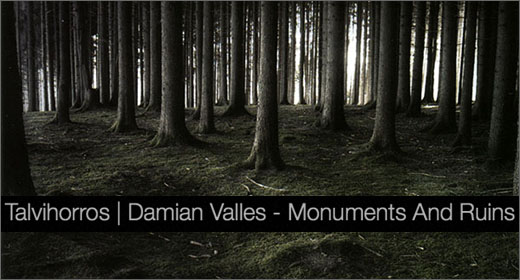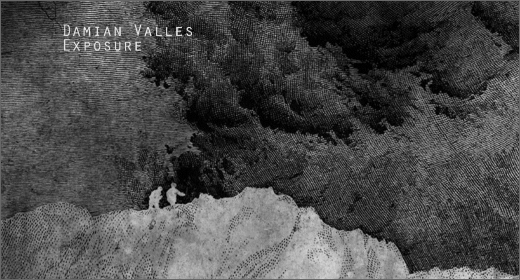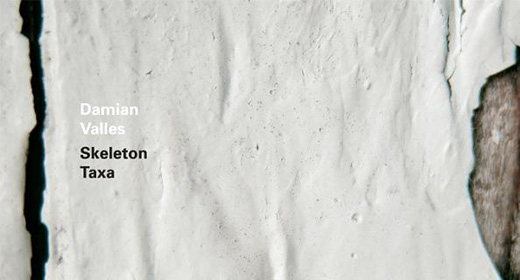Anache plays a lot with each sound he introduces, and instead of striving for some insane out-of-this world timbres like you may sometimes hear in guitar-driven electroacoustics, he focuses more on building with the more subtle tones he’s creating. Layering and constant variation make this a worthwhile LP for fans of atonal electronic music.
Bareboned
Lento, en un jardín lenticular is a 50 minute suite or improvisational electroacoustics, one that makes use of plenty of interesting textures. One thing I particularly like about electroacoustic music in general is peculiar timbres, given that the manipulation of sounds sources allows for quite a lot of interesting results, might as well amp that up as much as you can; on this record in particular, there’s barely any resemblance of traditional instruments, and focus on tonality is kept at an all time low. The big draw of this LP are indeed its timbres, but there’s also a lot of captivating moments in terms of composition, especially as one track directly follows the previous.
For starters, the initial run of tracks is really bareboned. There are some hisses of noise and some clicks, seemingly with no direction, as there’s no reward to the slow build up the album offers initially. It is building though, as the pieces get denser; silence is far less as “Por mi culpa” begins, while on the opener “Drishti” you were comforted by some really thin ambience scattered among periods of silence. It is “Por mi culpa” that widens the scope of sounds the record offers, as the clicks get so frequent they turn into a fuzzy noise, not necessarily becoming a pitch, but it builds a robust tone.
All of this then crumbles into silence yet again, almost as if this piece had a slow and controlled raptus; its calm ending allows for the introduction of the following track, “La llanura de las esferas.” Now, this one, this is a damn great drone piece. The lead drone is really cold and stiff, as it endlessly cycles its pulse, while behind that others join to create a wider sense of space; I really like the added layer that almost seems to mimic the lead, as it does so in much lighter and echoed way. Some bits of scattered clicky noises also pop up from time to time, and quickly fade away, granting the piece with those occasional additions that allow it to disrupt its hypnotic nature. The piece is constantly mutating too, because even if the pulsating drone I mentioned always maintains its presence, the others either thin out or become more sluggish, leading the piece to slowly go back to just that initial buzz, and also allowing to transition into the following track.
Surrounded by ethereal vocalizations ::
After “La llanura de las esferas,” I do think the album becomes a bit homogenous, but there are standouts anyways. “Obvio y obtuso” is perhaps the most memorable piece, mainly because of its use of vocals. Do not take that as me saying there’s live singing here, because the vocals—which are taken from a very short snippet anyways, as you can guess by hearing similarities between the chopped bits—are manipulated in a way that they resemble spirits more than they do human signing. Seriously, the piece is really haunting, as it starts off with what I assume are tongue or lips clicks, almost as if they were some sort of call, and after some silence you start to get surrounded by ethereal vocalizations. I’m pretty confident that every single sound you hear in this piece derives from a mouth, even the veiled pads in the background have a bit of a nasal tone to them that reassures me they’re sung—and not actually coming from a different plane of existence. That being said, the effect that all the different manipulations create is enveloping and pretty surreal, and while Anache does mention that the sound comes from a recording of his own voice, you would bet there’s at least three people used as source from how distinct he manages to make the snippets.
The other track that impresses me in the second half is “Un lienzo que fue velo,” as it is a cold and dry track to finish off the LP—it actually ends with a short epilogue which seems to borrow from other tracks on the album, wrapping up with a short reminder. Compositionally speaking, this might be the most straightforward track on the LP, as it seems to want to focus on just a handful of tones and on keeping them alive for as long as possible. There’s aren’t many new ones that get added as the piece progresses, rather what you hear at the beginning is what eventually morphs into the later parts of the piece, and you go from a very stiff metallic hiss to a smooth hollow drone; still, some tones do pop in and out, but I can’t drive my focus away from that one lead pitch that’s constantly staying the same for minutes, everything orbiting around it is kind of playing second fiddle and you’re just staring at this one straight line waiting for it to shift, which it eventually does so as I said.
On this album I found a lot of intriguing moments. When the music is as minimalistic as the one presented here, I appreciate when the musician(s) try to make the most of how little they’re displaying; Anache plays a lot with each sound he introduces, and instead of striving for some insane out-of-this world timbres like you may sometimes hear in guitar-driven electroacoustics, he focuses more on building with the more subtle tones he’s creating. Layering and constant variation make this a worthwhile LP for fans of atonal electronic music.
Lento, en un jardín lenticular is available on Inkilino. [Bandcamp]

























![Luke’s Anger :: Ceiling Walker EP (Love Love) — [concise]](https://igloomag.com/wp/wp-content/uploads/2025/04/lukes-anger-ceiling-walker-vinyl_feat-75x75.jpg)


